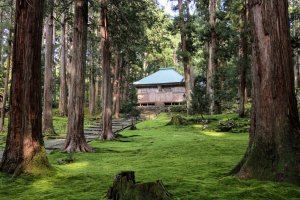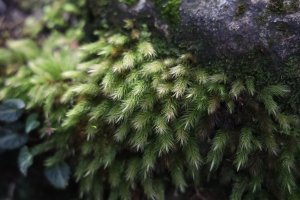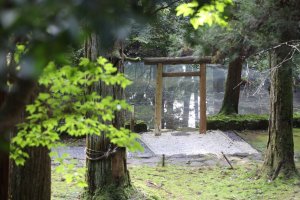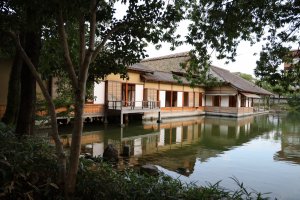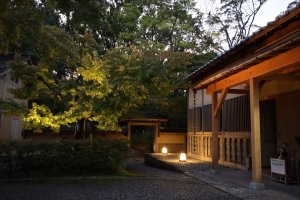The success of the Hokuriku bullet train has helped put Kanazawa city on the map, halving what was previously a 5-hour journey from Tokyo.
.article table { margin-bottom: 2em; width:100%; }
This is helping create new travel possibilities down to Kyoto far from the beaten path—which has historically involved taking the bullet train from Tokyo and going direct, flying by vast swathes of central Japan along the modern Tokaido line.
A journey to Kyoto from Kanazawa involves taking paths less traveled through Fukui and Shiga prefectures, which both promise their own dose of unique sightseeing and culture that can’t be had anywhere else.
In this two-part series, we introduce alternative routes linking up Kyoto and Kanazawa, unlocking largely undiscovered parts of Japan to visitors from overseas. You can reference the sample itinerary—with exact (weekday) timings—for this trip further below.
Day 1
Our journey south begins with our arrival in Fukui, starting with the exploration of one of its most impressive shrines at Heisenji before exploring Fukui City’s Yokokan Garden. Both provide impressive contrasts of nature and culture in harmony.
Our journey begins in earnest with a morning departure from Ishikawa’s capital of Kanazawa. Those travelling up in advance to explore the city’s cultural district may pass by the station’s symbolic Tsuzumi-mon—a towering wooden gate resembling a drum used in Noh theatre that makes a great meeting point. Otherwise, our focus is making headway in our journey south through Fukui making a few perfectly timed stops along the way.
Our first major stop is Heisenji Hakusan Shrine in the Katsuyama area of Fukui prefecture to the south, so we board the train at Kanazawa and head south to Fukui via the Limited Express JR Thunderbird service (45 min). Changing to the Katsuyama Eiheiji Line takes us to Katsuyama (53 min), where it makes sense to grab lunch before venturing on—picking up an ekiben (regional bento box) at Fukui Station is one time-saving idea. Finally, a short taxi ride gets us to Heisenji.

Created over 1,300 years ago, Heisenji Hakusan Shrine is said to have marked the beginning of the trail taken by pilgrims on their way to Mount Hakusan to the north-east. Just a few steps of your own into the temple grounds will give you a sense of the stunning yet sacred environment here. Much of the temple grounds are covered in moss—leading to the nickname kokedera (lit. moss temple)—giving the complex a spiritual sense of calm. Sunlight cascades through the tall cedar trees, gently illuminating the soft mossy undergrowth in this cool, mystical realm.
The serene calm and moss carpet underfoot creates a powerful impression that will surely take your breath away—though considered one of Fukui prefecture’s top shrines you will not see hordes of visiting tourists, thanks to its secluded location.
Make the most of it and enjoy a few hours soaking up the quiet calm of this tranquil paradise, before heading back to Fukui for one final stop.
Details: Heisenji Hakusan Shrine
| Place | Heisenji Hakusan Shrine (平泉寺白山神社) |
|---|---|
| Address | Heisenjicho, Katsuyama, Fukui 911-0822 |
| Tel | 0779-88-1591 |
| Opening | Always open |
| Website | heisenji.jp (Japanese) |
Taking the same route back to Fukui Station, it is worth stopping in at Yokokan Garden in the early evening before you retire for the night. It’s a 15-minute walk north of the station, which will take you past the Fukui Castle remains, but worth the short journey.

Despite its central location, this Edo period Japanese garden offers a tranquil environment from which to imagine life as one of Fukui’s former feudal lords who would have owned this residence. From 5pm as the sun starts to set, the garden lights will come on making for an extra pleasant stroll around the central pond and main teahouse.
Details: Yokokan Garden
| Place | Yōkōkan Garden (養浩館庭園) |
|---|---|
| Address | 3-11-36 Hoei, Fukui, 910-0004 |
| Opening | 9am-7pm (Closes 5pm Nov 6th-Feb 28th. Entry permitted up until 30 min before closing) |
| More | japantravel.com/yokokan-garden / fukuisan.jp/en/yokokan/ |
Fukui has plenty of hotels to choose from—something like Dormy Inn could be ideal if you are looking for Western comforts but still a touch of Japanese culture, with its rooftop hot spring and sauna a potential attraction for some.
Day 2
Today we are exploring a collection of cultural sites, including the Ichijōdani Asakura Family Historic Ruins to the south of Fukui and the Kumagawa Juku post town near the Shiga border, before moving into western Shiga. There we explore the charms of Harie’s waterways, as well as the local Kawashima Shuzo.
Take a 20-minute train ride east to Ichijodani station, before making a 15-minute walk to reach the site. A former castle town ruled by the Asakura family over 500 years ago during the Warring States period, the ruins at Ichijōdani provide a glimpse into a bygone era. Back in the day, Ichijōdani was comparable in size and swagger to Kyoto and Osaka’s Sakai before its eventual demise—a casualty of the Asakura’s costly conflict with warlord Oda Nobunaga.

It’s remarkable to be walking amongst the excavated remains of the three main highlights here: the Asakura residence, samurai quarters and wider townscape area. The main gate to the residence has been faithfully restored, helping you imagine what life was like beyond. It’s fascinating to reflect on the fact this sleepy, quiet area along Road 18—free of tourists entirely—once held significant sway and played its part in Japanese history. It is one of only four sites in Japan that hold three national designations in parallel; a Special Historic Site, Special Place of Scenic Beauty and an Important Cultural Property.
Details: Ichijōdani Asakura Family Historic Ruins
| Place | Ichijōdani Asakura Family Historic Ruins (一乗谷朝倉氏遺跡) |
|---|---|
| Address | Kidonouchicho, Fukui, Fukui 910-2153 |
| Tel | 0776-41-2330 |
| Opening | 9am-5pm |
| Website | htfukuisan.jp/en/asakura |
Our next main destination is the historic post town of Kumagawa Juku to the far south of Fukui, but first, we need to return to Fukui Station before veering south. As you reach Ichijodani station—check the bus times outside the nearby Asakura museum. Timed right, a bus will get you back to Fukui Station just as quick. It’s then about 1 hour 30 min to Wakasa Kumagawa via train then bus.

Kumagawa Juku was originally an important stop on the Wakasa Highway, a prosperous trade and supply route between the port region of Wakasa (modern-day Obama, Fukui) and Kyoto during the Edo period. Nicknamed ‘Saba Kaido’ (lit. Mackerel Highway), this route allowed fresh Mackerel—lightly salted to help last the journey—to be transported to the ancient capital.
Wandering the main street is like stepping back into the past, with traditional machiya townhouses lining the street. Step into the local museum to find out more about the area’s history.
Details: Kumagawa Juku
| Place | Kumagawa Juku (熊川宿) |
|---|---|
| Address | 11-1-1 Kumagawa, Mikatakaminakagun Wakasacho, Fukui 919-1532 |
| Tel | 0770-62-9111 |
| Opening | Always open |
| Website | kumagawajuku.jp (Japanese) |
To the south side of the historical post town area, you’ll stumble upon a handy rest stop or roadside service area which is an ideal stop for lunch. Step inside Shikisai-kan to try some local dishes, including Yaki Saba (grilled mackerel) Sushi, a local Fukui favourite. It’s worth browsing the souvenirs on display too—this is our last stop in Fukui, before continuing east over the nearby border into Shiga prefecture.
From here, catch a bus from the Tachibanamachi stop just north of the road station on Route 303 and alight at Omi-Imazu Station (a 30-minute journey), boarding a train to go one stop south to Shin-Asahi Station (4 min). Our final stop for the day is the Kawashima Shuzo (Sake Brewery), just a 15-minute walk east of the station.

Established over 150 years ago, Kawashima Shuzo invites visitors on a free tour of their facilities—which includes video introduction, sake tasting and demonstration of the sake making process if in-season (Nov 11–Feb 20). Visit the shop for souvenirs and savour the taste of their distinct sake, thanks to the purity of Harie's water.
Details: Kawashima Shuzo
| Place | Kawashima Shuzo (川島酒造) |
|---|---|
| Address | 83 Asahi, Shinasahicho, Takashima, Shiga 520-1501 |
| Tel | 0740-25-2202 |
| Opening | 9am-5pm |
| Website | https://www.sake-kawashima.co.jp/ (Japanese) |
By now you may have noticed the idyllic waterways that cut through Harie in western Shiga. Water brought down from the Hira mountain meets the basin of Lake Biwa, birthing this completely natural underground water supply. It makes for picturesque scenes of narrow canals snaking around the district and underpins the local kabata culture. Kabata are water supply systems that act as a kitchen for each household with their open water spring. Large koi carp even live in the kabata and feed off food scraps, helping purify the water before it re-enters the water system.
With the gentle trickle of these quiet streams providing a soothing backdrop, a stay in Harie comes recommended. Just around the corner from the brewery, Racine Home Harie does a modern take on the ryokan concept—with both Western/tatami rooms available, enjoy views of the waterway-inspired garden before dining in the restaurant. Local Omi beef, as well as sake from Kawashima Shuzo, are both on the menu to round out the day in the best possible way. Jump in the hot spring before retiring for the night—leaving the window ajar to listen to the trickling waterways outside provides a local therapy of sorts.

Details: Racine Home Harie
| Place | Racine Home Harie (ラシーヌホーム 針江) |
|---|---|
| Address | 235 Harie, Shinasahicho, Takashima, Shiga 520-1501 |
| Tel | 0740-20-6570 |
| Website | harie.jp/english |
Day 3
Exploring the western shore of Lake Biwa allows us to discover a range of attractions, including Shirahige-jinja Shrine’s floating tori gate, the home of Japan’s Funazushi, the elegant Omi-jingu Shrine and Ukimido hall overlooking Biwa’s waters.
After recharging from breakfast, we return to Shin-Asahi Station to take the train two stops to Omi-Takashima station. Our first destination is nearby Shirahige-jinja Shrine on the western shore of Lake Biwa. It’s an ideal cycle ride and, handily, Omi-Takashima has rental cycles available to hire for this very purpose.
Although it pays to visit the shrine’s main hall itself—a national Important Cultural Property—the actual main attraction here is the Instagram-friendly giant floating torii gate found just offshore. Comparisons with Miyajima’s own floating torii will abound, but it makes a great photo opportunity that is a little off the beaten path given its location.

Details: Shirahige-jinja Shrine
| Place | Shirahige-jinja Shrine (白鬚神社) |
|---|---|
| Address | 215 Ukawa, Takashima, Shiga 520-1122 |
| Tel | 0740-36-1555 |
| Opening | 9am-5pm |
| Website | shirahigejinja.com (Japanese) |
On our way back to the station, we want to veer a bit further north to find Kitashina—a shop that has been making Funazushi via traditional fish preservation methods for over 400 years. It is considered the last of its kind and a heritage of Shiga’s traditional cuisine. It is worth taking a peek to see how this tradition is being preserved. Funazushi predates the modern sushi we all know, as it uses salted and aged Nigoro-buna fish wrapped in vinegared rice and then fermented. The actual dish is an acquired taste and perhaps not suited to everyone, but it is no less significant a landmark from which to admire this unique precursor to sushi cuisine.

Details: Souhonke Kitashina
| Place | Souhonke Kitashina (総本家 喜多品老舗) |
|---|---|
| Address | 1287 Katsuno, Takashima, Shiga 520-1121 |
| Tel | 0740-20-2042 |
| Opening | 10am-5pm |
| Website | 400-kitashina.com (Japanese) |
Returning our bicycles to Omi-Takashima, we now travel 30 minutes south, further along the JR Kosei Line to Katata Station. It’s then a 20-minute walk towards the lakeshore to find our next destination, the floating Ukimido hall at Mangetsuji Temple. It is considered one of the Eight Views of Omi for its beauty, and looks beautiful against Lake Biwa’s waters.

Details: Ukimido Hall (Mangetsuji Temple)
| Place | Ukimido Hall at Mangetsuji Temple (満月寺 浮御堂) |
|---|---|
| Address | 1-16-18 Honkatata, Otsu, Shiga 520-0242 |
| Tel | 077-572-0455 |
| Opening | 8am-5pm |
| Website | en.biwako-visitors.jp |
Given the walking involved, let’s grab lunch at nearby Pecorino (Italian) on the way back to Katata Station, and take a well-deserved break.
For the afternoon, we want to continue our journey south along Lake Biwa’s western shore, where we will arrive at Omi-jingu Shrine—a 15-minute walk north of Otsukyo Station. Omi-jingu is a magnificent yet tranquil environment to explore and is relatively modern in construction from 1940. It is an example of the Showa construction style and, better yet, you can complete your experience here by swapping backpack for authentic kimono. At just ¥1,000 for an hour, you can stroll around the shrine’s grounds, soak up the atmosphere and take some memorable photos.

Details: Ōmi-jingū Shrine
| Place | Ōmi-jingū Shrine (近江神宮) |
|---|---|
| Address | 1-1 Jingucho, Otsu, Shiga 520-0015 |
| Tel | 077-522-3725 |
| Opening | 6am-6pm |
| Website | oumijingu.org (Japanese) |
After another day’s sightseeing, it’s the ideal time to think about checking in at our ryokan for tonight—Satoyu Mukashibanashi Yuzanso. We travel north back along the Kosei Line to Ogoto Onsen Station, before being picked up by a Yuzanso shuttle to take us to this grandiose hilltop onsen ryokan.
Yuzanso offers incredible comfort, Japanese-style food, hot springs, and sauna. Several room types even include your own private rotemburo (outdoor baths) attached directly to the room, offering views of Lake Biwa. Make the most of your surroundings by relaxing and recharging after a long day.

Details: Satoyu Mukashibanashi Yuzanso
| Place | Satoyu Mukashibanashi Yuzanso (里湯昔話 雄山荘) |
|---|---|
| Address | 1-9-28 Ogoto, Otsu, Shiga 520-0101 |
| Tel | 077-578-1144 |
| Website | yuzanso.co.jp/f/e/ |
Day 4:
Our main goal for our last day is to make our way to the spiritual mountaintop temple of Enryakuji Temple on Hieizan (Mount Hiei), before making our descent into Kyoto. The mountain’s summit cuts through the border of Kyoto and Shiga prefecture, with an impressive cable car system allowing visitors to ride up on one side, and down the other.
Taking a Yuzanso shuttle transfer back to Ogoto Onsen Station, we head south one stop to Hieizan-Sakamoto Station and make our way slowly west. Our ultimate goal is the cable car station, Cable Sakamoto Station, which would take us up Hieizan. First, however, we want to spend a bit of time in this area. One highlight is the Former Chikurin-in Temple, with its immaculate Japanese garden and tea houses. The view from the second-floor tatami room over the garden is a highlight.

Details: Former Chikurin-in Temple
| Place | Former Chikurin-in Temple (旧竹林院) |
|---|---|
| Address | 5-2-13 Sakamoto, Otsu, Shiga 520-0113 |
| Tel | 077-578-0955 |
| Opening | 9am-5pm |
| Website | kyuchikuriin.web.fc2.com (Japanese) |
Next up, we want to take an early lunch before taking the lift up to Hieizan—where options are more limited. Nearby Honke Tsuruki Soba is a top soba restaurant serving up incredible soba and tempura dishes.

Details: Honke Tsuruki Soba
| Place | Honke Tsuruki Soba (本家 鶴㐂そば) |
|---|---|
| Address | 4-11-40 Sakamoto, Otsu, Shiga 520-0113 |
| Tel | 077-578-0002 |
| Opening | 10am-5:30pm |
| Website | tsurukisoba.com (Japanese) |
With our stomachs fed, we continue to Cable Sakamoto Station, and take the next available cable car up the mountain, along the Hieizan Sakamoto Cable Car Line.

Founded in 788, Hieizan Enryakuji Temple is considered the home of Japan’s Tendai Buddhism and one of Japan’s most significant temples. Many of the monks who studied here went on to found other sects within Buddhism. Take the time to explore the vast grounds, including the main hall — it’s undergoing restoration work until 2026 but can still be entered.
Details: Hieizan Enryakuji Temple
| Place | Hieizan Enryakuji Temple (比叡山延暦寺) |
|---|---|
| Address | 4220 Sakamotohonmachi, Otsu, Shiga 520-0116 |
| Tel | 077-578-0001 |
| Opening | 8:30am-4:30pm (Saito and Yokawa 9am-4pm) Varies by season |
| Website | hieizan.or.jp (Japanese) |
Once we’re done, there’s actually a shuttle bus service from Enryakuji bus center to Hieizan Sancho Station, from where we take a series of cable car and ropeway to get to Cable Yase Station before transiting to Kyoto’s local trains that can take us soon enough to Kyoto Station by late afternoon.
Our Itinerary
The aforementioned course follows a customized route through Fukui and Shiga—for your reference we share the exact timings and connections below (correct as of November 2019). Don’t forget to consult our companion article on an alternative reverse itinerary, if you are looking to start from Kyoto.
| Day | Time | Location | Memo |
|---|---|---|---|
| 1 | 09:54 | Kanazawa Station | Departure: JR Tokkyu Thunderbird #16 for Osaka |
| 10:40 | Fukui Station | Arrival | |
| 10:55 | Fukui Station | Katsuyama Eiheiji Line for Katsuyama | |
| 11:48 | Katsuyama Station | Arrival / lunch | |
| 12:45 | Katsuyama Station | Depature by taxi | |
| 13:00 | Heisenji | Arrival / sightseeing | |
| 15:00 | Heisenji | Departure via taxi | |
| 15:15 | Katsuyama Station | Arrival | |
| 15:49 | Katsuyama Station | Katsuyama Eiheiji Line for Fukui | |
| 16:42 | Fukui Station | Arrival, then head to Yokokan Garden | |
| 17:00 | Yokokan Garden | Arrive for light-up event | |
| 2 | 9:08 | Fukui Station | Departure |
| 9:25 | Ichijodani Station | Arrival, walk to ruins (15min), sightseeing | |
| 10:56 | Bus Stop: Ichijodani Asakura Family Museum | Departure for Fukui | |
| 11:12 | Fukui Station | Arrival | |
| 11:43 | Fukui Station | Departure: Thunderbird #18 LE, for Osaka | |
| 12:14 | Tsuruga Station | Arrival | |
| 12:20 | Tsuruga Station | Departure: Obama line, bound for Higashi-Maizuru | |
| 13:08 | Kaminaka Station | Arrival | |
| 13:16 | Kaminaka Station | Departure by bus for Wakasa-Kumagawa | |
| 13:24 | Wakasa-Kumagawa | Arrival: Kumagawa-juku and Shikisai-kan | |
| 15:25 | Tachibanacho | Take bus (Jyakkou Line) for Omi-Imazu Station | |
| 15:53 | Omi-Imazu Station | Arrival | |
| 16:08 | Omi-Imazu Station | Departure (Kosei Line) for Himeji | |
| 16:12 | Shin-Asahi Station | Kawashima Shuzo sightseeing, then check in to hotel | |
| 3 | 10:14 | Shin-Asahi Station | Departure (JR Kosei Line) |
| 10:21 | Omi-Takashima Station | Arrival, rental cycle at Tourist Information at station | |
| 11:15 | Shirahige-jinja Shrine | By bicycle | |
| 11:45 | Kitashina | By bicycle, before returning to station | |
| 12:21 | Omi-Takashima Station | Departure | |
| 12:39 | Katata Station | Arrival: walk to Ukimido | |
| 13:30 | Lunch | Nearby restaurant (e.g Pecorino) | |
| 14:41 | Katata Station | Departure | |
| 14:54 | Otsukyo Station | Walk to Omi-jingu shrine, sightseeing | |
| 16:38 | Otsukyo Station | Departure | |
| 16:48 | Ogoto-onsen Station | Shuttle bus to ryokan | |
| 4 | 9:41 | Ogoto-onsen Station | Departure |
| 9:44 | Hieizan-Sakamoto Station | Arrival: walk around area, Former Chikurin-Temple, soba lunch | |
| 12:30 | Cable Sakamoto Station | Departure, take cable-car up mountain | |
| 12:40 | Motate Yama Station | Arrival, explore Hieizan Enryakuji temple | |
| 14:43 | Enryakuji Bus Centre | Shuttle bus | |
| 14:50 | Hieizan Sancho Station | Arrival | |
| 15:20 | Hieizan Sancho Station | Departure | |
| 15:23 | Ropeway Hiei Station | Arrival | |
| 15:35 | Cable Hiei Station | Departure | |
| 15:44 | Cable Yase Station | Arrival | |
| 16:10 | Yase-Hieizanguchi Station | Departure | |
| 16:23 | Demachiyanagi Station | Arrival | |
| 16:28 | Demachiyanagi Station | Departure | |
| 16:40 | Tofukuji Station | Arrival | |
| 16:52 | Tofukuji Station | Departure | |
| 16:54 | Kyoto Station | Arrival |




























